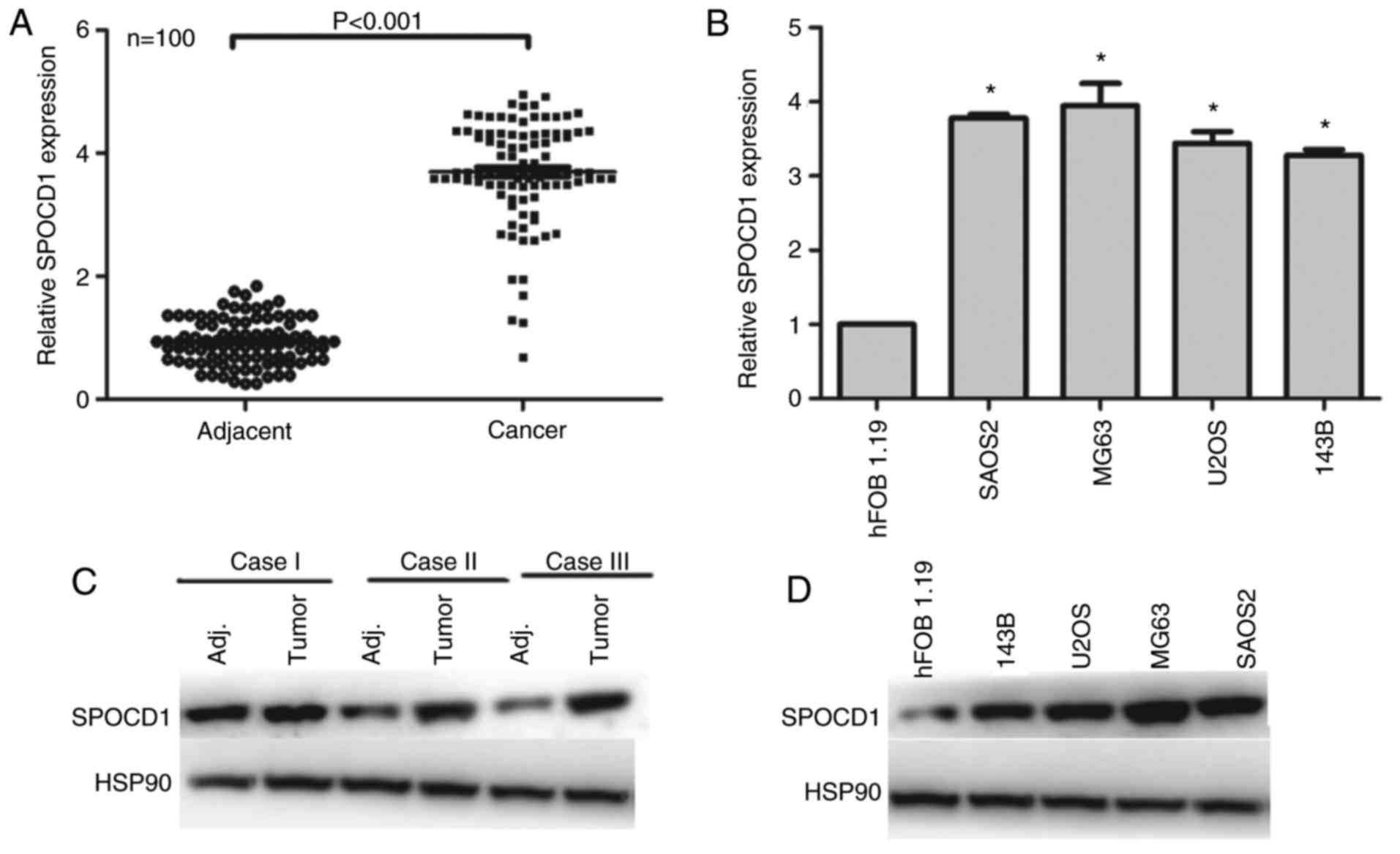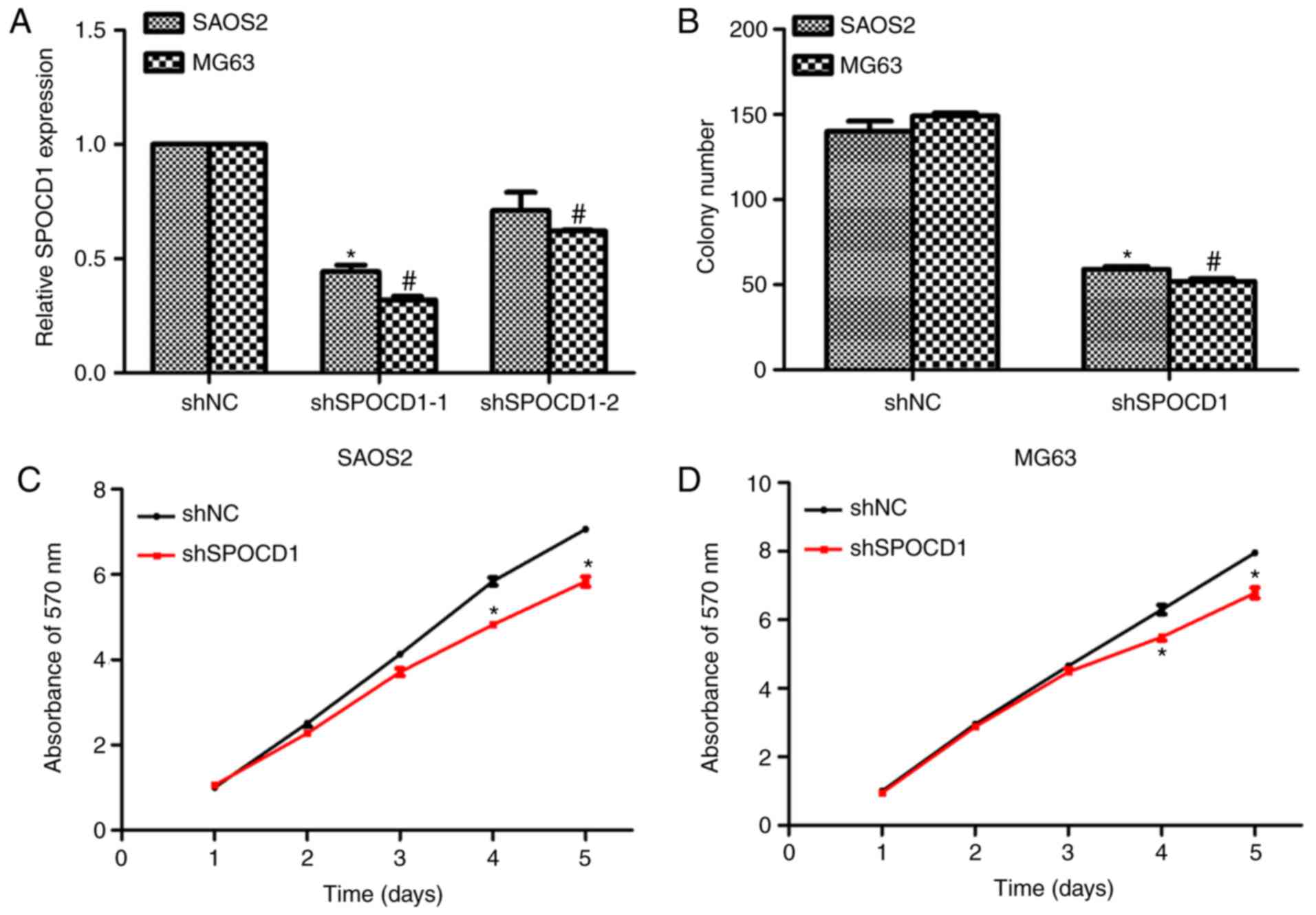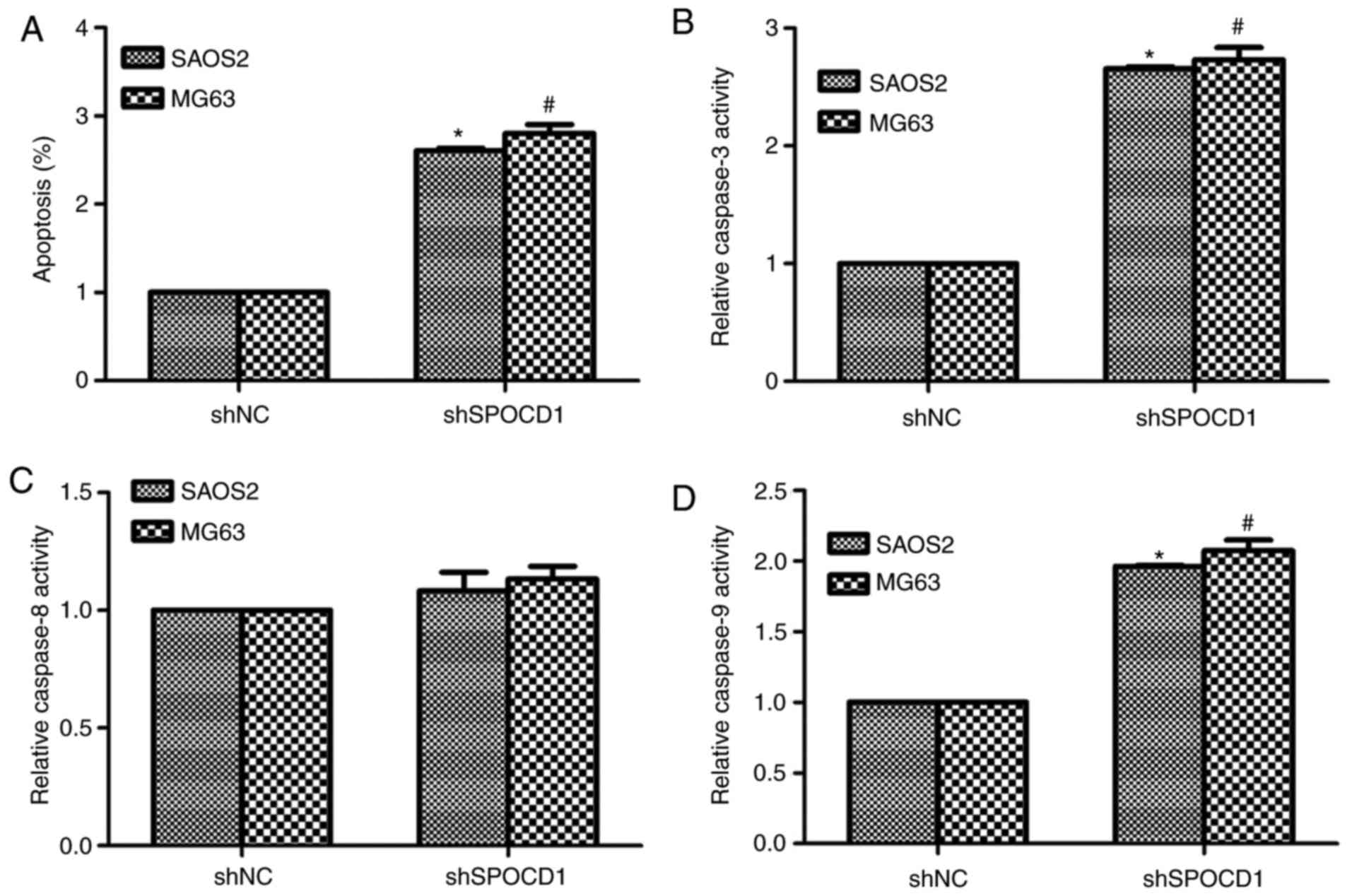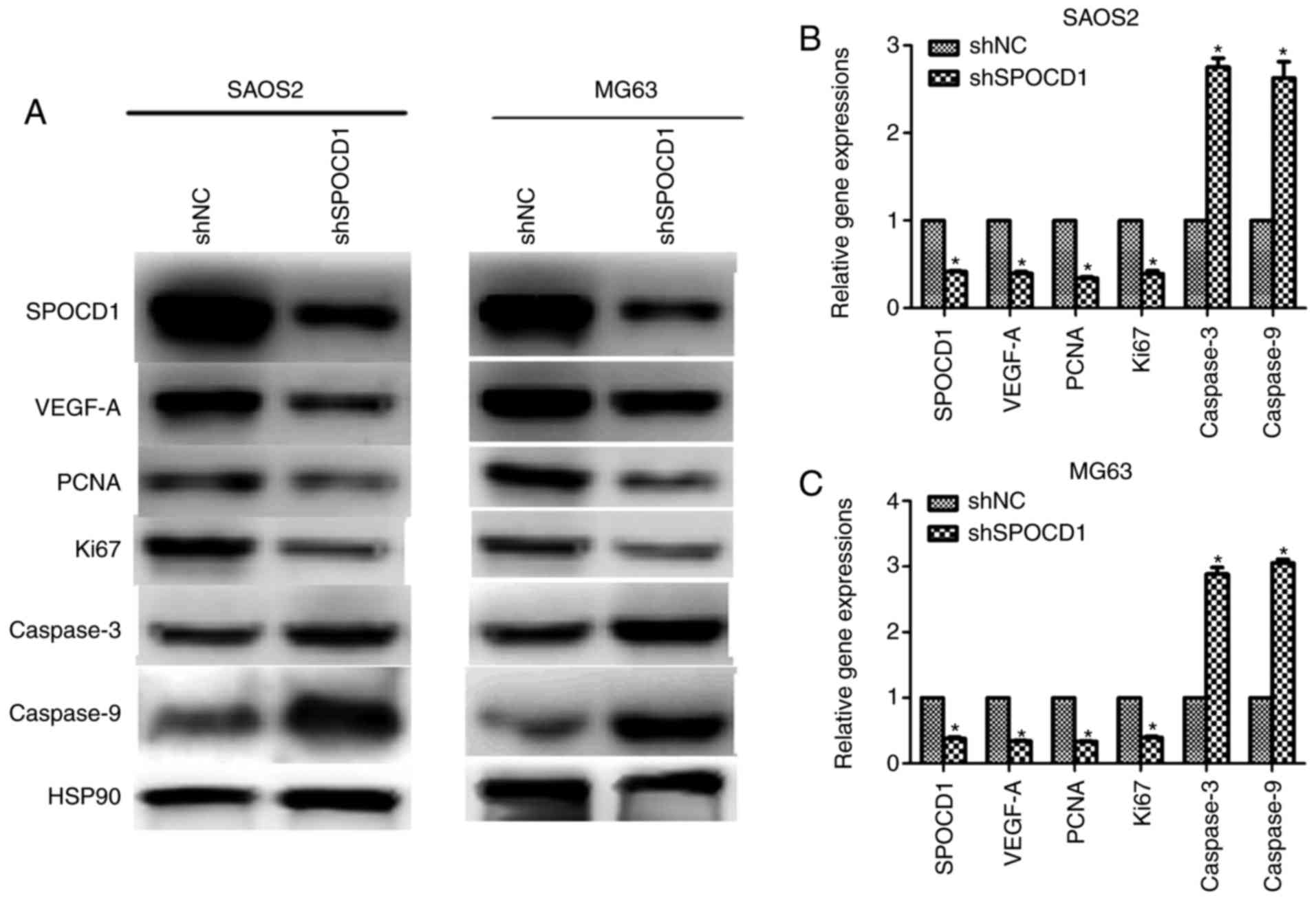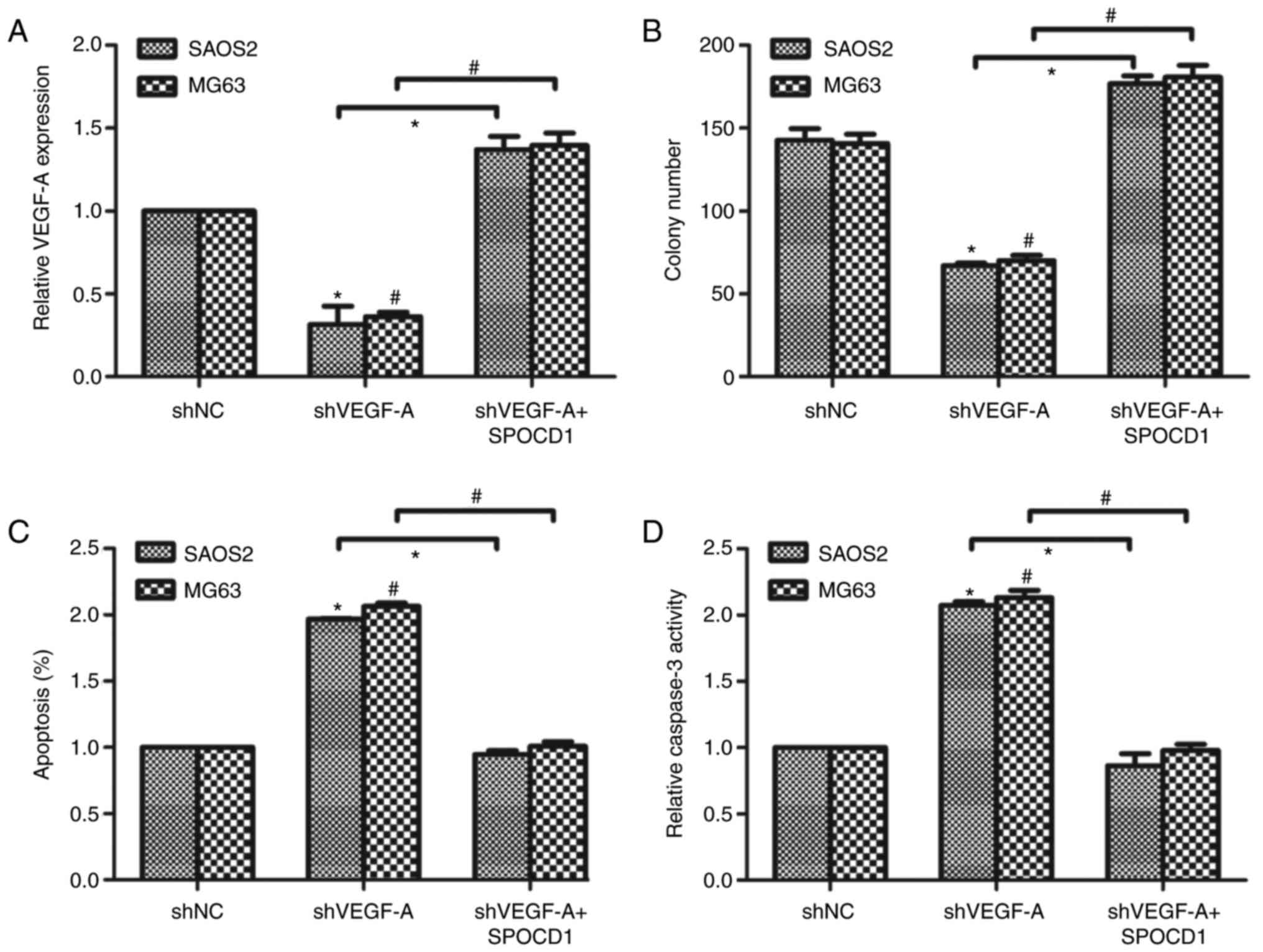SPOCD1 promotes cell proliferation and inhibits cell apoptosis in human osteosarcoma
- Authors:
- Published online on: December 12, 2017 https://doi.org/10.3892/mmr.2017.8263
- Pages: 3218-3225
Abstract
Introduction
Osteosarcoma is one of the most common primary bone malignancies in young adults and adolescents, with an estimated 5.6 per million children suffering from osteosarcoma yearly (1,2). Osteosarcoma occurs mostly in long extremity bone and around regions with active bone growth (3,4). In spite of the recent advances in the treatment of osteosarcoma, which were mainly based on chemotherapy, radiotherapy and surgery, the 5-year survival rate remains still dim for patients suffering from osteosarcoma (1,5). Thus, it is an imperative to uncover the molecular mechanisms underlying the development and progression of osteosarcoma and to identify novel biomarkers for the treatment, diagnosis and prognosis of this malignancy (6).
Spen paralogue and orthologue C-terminal (SPOC) domain containing 1 (SPOCD1) is a recently identified novel gene that encodes a protein belonging to the transcription factor S-II (TFIIS) family of transcription factors (7). SPOCD1 was initially found to interact with testis protein phosphatase 1 which is a major eukaryotic serine/threonine-specific phosphatase regulating cellular signaling (8). It was hypothesized that SPOCD1 might be involved in the regulation of cell developmental since it contains the SPOC domain which is normally involved in developmental signaling (8). However, the exact roles of SPOCD1 in biological processes have remained mysterious and received no experimental exploration.
Recently SPOCD1 has been recognized as a tumor-related factor. An illumine microarray study has shown that SPOCD1 independently discriminated progressive from non-progressive bladder cancer patients with a sensitivity of 79% and a specificity of 86% (AUC=0.83) (9). SPOCD1 was overexpressed in gastric tumors and knockout of SPOCD1 reduced gastric cancer cell proliferation, invasion and migration activities in vitro and in vivo (10). An exome array analysis has further identified that a low-frequency missense variant (rs1127549280) in the SPOCD1, at 1p35.2, was reproducibly associated with reduced risk of gastric cancer (odds ratio=0.56; P=3.48×10−8) (10). In addition, it has been recently found that SPOCD1 is significantly upregulated in human masticatory mucosa during wound healing (11), raising a hypothesis that SPOCD1 might regulate cell proliferation and migration processes. These pioneer reports implicated the biological significance of SPOCD1 in human tumorigenesis.
The present study aimed to evaluate the expression profile and functional roles of SPOCD1 in osteosarcoma. Expression of SPOCD1 in clinical osteosarcoma tissues and in a series of osteosarcoma cell lines were initially examined. Loss-of-function approach was utilized to assess the effects of SPOCD1 modulation on cell aggressive activities. Molecular mechanisms of how SPOCD1 exerts its function in osteosarcoma were also explored. Our study might pave novel insights into the treatment of osteosarcoma in clinic.
Materials and methods
Human samples
A total of 100 osteosarcoma tissues and their adjacent non-cancerous tissues were collected from Department of Orthorpaedic Surgery, Peking Union Medical College Hospital during 2013–2015. All of the tissues were frozen into liquid nitrogen as soon as dissected from human body during the surgeries. The clinical data were also recorded for statistical analysis. Each patient showed their full consent to participate in our study. The present study was approved by the Ethics Committee of Peking Union Medical College Hospital.
Cell culture and transfection
Human osteosarcoma cell line SAOS2 and MG63 were purchased from the cell bank of Shanghai Biological Institute, Chinese Academy of Science (Shanghai, China). Other two osteosarcoma cell lines U2OS, as well as the normal cell line HFOB1.19 were purchased from American Type Tissues Collection (American Type Culture Collection, Manassas, VA, USA). All culture media (DMEM; Gibco; Thermo Fisher Scientific, Inc., Waltham, MA, USA) were supplied with 10% fetal bovine serum (FBS; Gibco; Thermo Fisher Scientific, Inc.). Cell were maintained at 37°C in a humidified atmosphere of 5% CO2. Cell transfection was conducted with lipofectamine 2000 (Invitrogen; Thermo Fisher Scientific, Inc.) according to the manufactures' instructions. The culture medium was replaces every two days, otherwise as stated.
RNA isolation and RT-PCR
Total RNAs from human tissues and cultured cells were extracted using a standard Trizol reagent (Takara Biotechnology Co., Ltd., Dalian, China). RNAs were quantified by Nanodrop™ 2000 by collecting the OD260 absorbance and then immediately reversely transcribed into cDNA using Prime Script TM Master Mix (Takara Biotechnology Co., Ltd.) according to the manufacturer's instructions. Then, qRT-PCR was performed with SYBR® Premix EX Taq II™ (Takara Biotechnology Co., Ltd.) according to its product manual on the real-time PCR detection system ABI7900 (Thermo Fisher Scientific, Inc.). GAPDH was used as the internal reference, and gene mRNA expression were calculated by 2−ΔΔCt method (12). The thermocycling protocol was listed as below: Initial denaturation at 95°C for 5 min, followed by 45 repeats of a three-step cycling program consisting of 10 sec at 95°C (denaturation), 10 s at 60°C (primer annealing) and 10 sec at 72°C (elongation), and a final extension step for 10 min at 72°C. The primer sequences used for qPCR are listed below: SPOCD1: Forward: 5′-CTCCCCAAGTTGCTGACCTG-3′ and Reverse: 5′-CCCCTGTAGCGGGCAAATATC-3′. VEGF-A: Forward: 5′-AGGGCAGAATCATCACGAAGT-3′ and Reverse: 5′-AGGGTCTCGATTGGATGGCA-3′. GAPDH: Forward: 5′-GTGGACATCCGCAAAGAC-3′ and Reverse: 5′-AAAGGGTGTAACGCAACTA-3′.
Western blot analysis
Cells or tissues were lysed in lysis buffer (2% mercaptoethanol, 20% glycerol, 4% SDS in 100 mM Tris-HCl buffer, pH 6.8) with a freshly added protease inhibitor cocktail (Thermo Fisher Scientific, Inc.). The total protein extracts were quantified using a BCA assay kit (Thermo Fisher Scientific, Inc.). An equal amount of 40 ug protein extracts were loaded to 12% sodium dodecyl sulfatepolyacrylamide gel electrophoresis (SDS-PAGE) apparatus and transferred to a PVDF membrane (EMD Millipore, Billerica, MA, USA). Next, proteins were detected by specific antibodies using an enhanced chemiluminescence (EDM Millipore). The immunoreactive bands were quantified by the densitometry with ImageJ software when necessary. The primary antibodies against SPOCD1 (ab122188), VEGF-A (ab46154), PCNA (ab29) and Ki67 (ab16667) were commercially purchased from Abcam (Cambridge, CA, USA). The primary antibodies against caspase-3 (sc271759), caspase-9 (sc-7885) and secondary antibodies were purchased from Santa Cruz Biotechnology, Inc., (Dallas, TX, USA). All of the antibodies were diluted with a ratio of 1:1,000.
Colony formation assay
To observe the relative long-term effect of SPOCD1 on cell proliferation, colony formation assays were performed. In brief, SAOS2 and MG63 cells were transfected with scramble shRNA (shNC) or SPOCD1 shRNA (shSPOCD1) for 48 h and re-seeded in 6-well plates at an initial density of 900 cells/well and allowed to grow for 14 days to form natural colonies. At the end of monitored time, cells were washed by PBS for three times, treated with crystal violet for 30 min at room temperature, and washed twice by deionized water. Then, colonies in each group of cells were photographed using a digital camera (Nikon Corporation, Tokyo, Japan) and the number of colonies was counted.
Cell proliferation analysis
Cell viability was determined using the methylthiazoletetrazolium (MTT) assay. SAOS2 and MG63 cells were transfected with shRNAs in the presence or absence of SPOCD1 knockdown for 48 h and then trypsinized and reseeded in triplicate in 96-well plates at an initial density of 4,000 cells per well. Cell numbers were monitored for a total of 5 consecutive days. At each indicated time points, cells culture were added with 10 µl of MTT solution (5 mg/ml) per well. After 2 h incubation at room temperature, the absorbance of plate was recorded at 570 nm. Cell viability was defined as the cell number ratio of experimental groups to control cells.
Cell apoptosis
The annexin V/PI assay was performed according to the manufacturer's instructions (Invitrogen; Thermo Fisher Scientific, Inc.). Briefly, SAOS2 and MG63 cells were plated into 6-well plates and transfected with control or specific shRNA against SPOCD1. Afterwards, cells were washed with pre-cold PBS, trypsinized, and re-suspended in 100 µl of binding buffer with 2.5 µl FITC conjugated annexin-v and 1 µl PI (100 µg/ml). Cells were then incubated at room temperature for 15 min in darkness. A total of at least 10,000 events were collected and calculated by flow cytometry (BD Biosciences, San Jose, CA, USA).
Relative caspase activities
The activities of caspase-3, caspase-8 and caspase-9 were determined by the caspase activity kits (Beyotime Institute of Biotechnology, Nantong, China) based on the instructions. Briefly, cells were transfected with shRNAs for the 48 h. Afterwards, cell lysates were collected by low speed centrifuge (1,000 g, 5 min, 4°C). An equal amount of 10 µl proteins from each sample were added into 96-well plates and mixed with an aliquot of 80 µl reaction buffer supplied with caspase substrates (2 mM). After incubated at 37°C for 4 h, caspase activities were determined by the TECAN reader at an absorbance of 450 nm.
Statistical analysis
GraphPad Prism v5.0 (GraphPad Software, Inc., La Jolla, CA, USA) software was used for statistical analysis. Data are shown as mean ± standard deviation (SD). The two-tailed Student's t-test was used for comparisons between groups. Chi-square test was used to compare differences among categorical variables. P<0.05 was considered to indicate a statistically significant difference.
Results
SPOCD1 was overexpressed in human osteosarcoma in vivo and in vitro
First, we examined the expression of SPOCD1 in 100 of osteosarcoma patients. As shown in Fig. 1A, the expression of SPOCD1 was increased in 98% of cases compared with their adjacent non-cancerous tissues (P<0.001). Of note, we identified those, which had a higher expression of SPOCD1 than the median level as high expression of SPOCD1 (n=56), otherwise as low expression of SPOCD1 (n=44). The clinical variables were also analyzed and it was shown that the expression of SPOCD1 was associated with tumor size and TNM stages, but not age, sex and lymph node metastasis (Table I). Afterwards, four of the osteosarcoma cell lines were chosen for RT-PCR analysis and hFOB 1.19 was included as internal control. It was shown that all four osteosarcoma showed higher expression of SPOCD1 than the control cell, of which SAOS2 and MG63 showed the highest expression, thus, were chosen for subsequent analysis (Fig. 1B). As for the protein levels, most of the tumor tissues showed higher SPOCD1 expression than their corresponding counterparts and three of them were listed in Fig. 1C. Similarly, the protein levels of SPOCD1 in U2OS, MG63 and SAOS2 cells were all significantly increased than the control hFOB1.19 cells (Fig. 1D). These data suggested that the expression of SPOCD1 were remarkably increased in human osteosarcoma tissues and cells.
Knockdown of SPOCD1 in human osteosarcoma cells inhibited cell proliferation
To assess the role of SPOCD1 in human osteosarcoma, two specific shRNAs against SPOCD1 were designed, synthesized and transfected into SAOS2 and MG63 cells. As shown in Fig. 2A, SPOCD1 expression was decreased by more than 50% for both cell lines when shSPOCD1-1 was transfected, however, the knockdown efficiency was not significant when cells were treated with shSPOCD1-2. Therefore, only shSPOCD1-1 was used in later study and renamed as shSPOCD1. Colony formation assays were performed to explore the effects of SPOCD1. Approximate 140 SAOS2 cell colonies and 150 MG63 cell colonies were observed in control cells, while only 65 SAOS2 colonies and 55 MG63 colonies were counted when cells were transfected with shSPOCD1 (Fig. 2B). There were no notable differences between shNC- and shSPOCD1- treated cells in the former three days for both SAOS2 and MG63 cells. However, the cell proliferative rate was dramatically decreased in the fourth and fifth day in both cell lines when SPOCD1 was knocked down (Fig. 2C and D). These results showed knockdown of SPOCD1 in SAOS2 and MG63 cells inhibited cell proliferation.
Knockdown of SPOCD1 in SAOS2 and MG63 cells increased cell apoptosis by promoting the activities of caspase-3 and caspase-9
Based on Table I, the expression of SPOCD1 was associated with tumor size and TNM stages, we then examined the role of SPOCD1 in cell apoptosis. Obviously, the cell apoptotic rate was significantly increased by depletion of SPOCD1 in SAOS2 cells (about 2.4-fold) and MG63 cells (2.7-fold) (Fig. 3A). Then we also detected the relative caspase activities with a Beyotime kit. As shown in Fig. 3B, the relative activities of caspase-3 were increased by 2.4-fold and 2.5-fold, respectively, in SAOS2 and MG63 cells when cells were stimulated with shRNA against SPOCD1. However, the activity of caspase-8 remained stable with or without shSPOCD1 treatment in both cell lines (Fig. 3C). The activities of caspase-9 were also detected and it was shown to increase 1.75-fold and 1.86-fold in SAOS2 and MG63 cells, separately, after transfection of shSPOCD1 for 48 h (Fig. 3D). All of these data suggested that depletion of SPOCD1 increased cell apoptosis by increasing the activities of caspase-3 and caspase-9, but not caspase-8.
Depletion of SPOCD1 decreased the expression of VEGF-A in mRNA and protein levels
We tried to figure out how these effects of SPOCD1 resulted from, the expression of vascular endothelial growth factor A (VEGF-A) was examined. As shown in Fig. 4A, when SPOCD1 was knocked down in SAOS2 and MG63, the protein levels of proliferative markers PCNA and Ki67 were notably decreased and the expressions of caspase-3 and caspase-9 were increased, which further confirmed former observations in Figs. 2 and 3 (Fig. 4A). Interestingly, the protein level of VEGF-A was also decreased after depletion of SPOCD1 in both cell lines. Meanwhile, the mRNA levels of VEGF-A, PCNA and Ki67 were also decreased in both cells while those of caspase-3 and caspase-9 increased when cells were transfected with shSPOCD1 (Fig. 4B and C). These data altogether with the former ones revealed that SPOCD1 regulated cell proliferation and apoptosis by mediating the expression of VEGF-A.
Knockdown of VEGF-A revised the effects of SPOCD1 on cell proliferation and cell apoptosis
Next, we designed a specific shRNA against VEGF-A and transfected it into SAOS2 and MG63 cells. It was shown that knockdown of VEGF-A caused the mRNA level of VEGF-A to drop about 30% of the original ones. We then co-transfected the cells with shVEGF-A and SPOCD1 plasmid and found that the mRNA level of VEGF-A was increased to 1.4-fold compared to the control cells (Fig. 5A). Afterwards, cell proliferative rate and cell apoptosis were again examined. As shown in Fig. 5B, knockdown of VEGF-A decreased colony formation abilities while co-transfection of SPOCD1 plasmid increased colony numbers. Similarly, knockdown of VEGF-A in SAOS2 and MG63 cells increased cell apoptotic rate notably, while SPOCD1 overexpression decreased cell apoptosis to basal level in both cell lines (Fig. 5C). Then, the relative activities of caspase-3 were detected and it was found that depletion of VEGF-A in osteosarcoma cells increased the caspase-3 activity and overexpression of SPOCD1 suppressed the relative activity of caspase-3 in SAOS2 and MG63 cells (Fig. 5D). These data suggested the effects of SPOCD1 on cell proliferation and cell apoptosis were associated with the expression of VEGF-A.
Discussion
Osteosarcoma is responsible for approximate 20% of all primary bone sarcomas, and associated with a relatively high mortality rate, especially among children and adolescents (13). Osteosarcoma arises within the long extremity bones and has high metastasis properties. Conventional treatment strategy for osteosarcoma comprises of chemotherapy with the assistance of surgical resections (14). However, the risk adaptation of chemotherapy for individuals varies and the satisfaction of postoperative clinical stratification differs due to the differences in tumor size and sensitivity of patients to chemotherapy (15). Therefore, identification of novel therapeutic targets for osteosarcoma remains an imperative in clinic.
SPOCD1 is a novel gene that belongs to the transcription factor S-II (TFIIS) family and is implicated in developmental regulation (7). Emerging evidence has shown the clinical significance of SPOCD1. The present study evaluated the functional roles of SPOCD1 in osteosarcoma. Through examination of serial clinical osteosarcoma tissues and osteosarcoma cell lines, it was found that SPOCD1 was significantly overexpressed in clinical cancerous tissues as compared with adjacent non-cancerous tissues. SPOCD1 was also exclusively upregulated in osteosarcoma cell lines, particularity in more invasive cell lines MG63 and SAOS2. Interestingly, clinical statistics revealed that expression of SPOCD1 was significantly associated with tumor size and TNM staging, but did not correlate with patients' age or sex. Downregulation of SPOCD1 using shRNA approach caused significant decreases in cell proliferation rate and colony formation capacities. Considering that deregulated cell proliferation is a hallmark of cancer (16), these data supported that SPOCD1 promoted tumor growth in osteosarcoma. Moreover, inhibition of cell apoptosis is a good basis for tumor cell growth (17). Two major pathways are known to be involved in the initiation of apoptosis: the mitochondria-mediated intrinsic pathway and the death receptor-induced extrinsic pathway (18). The mitochondria-mediated intrinsic pathway depends on the release of cytochrome c which leads to the caspase-9-dependent activation of caspase-3. By contrary, the death receptor-induced extrinsic pathway signals in a caspase-8 dependent way. Our results showed that knockdown of SPOCD1 led to significant promotion of cell apoptosis in MG63 and SAOS2 cells. Further evaluation of major caspase activities revealed that caspase-3 and caspase-9, instead of caspase-8, were modulated by SPOCD1 knockdown, indicating that SPOCD1 inhibits cell apoptosis in an intrinsic apoptotic pathway. In all, these data suggested that SPOCD1 promoted cell proliferation and inhibited cell apoptosis in human osteosarcoma.
Interestingly, we identified VEGF-A as a downstream target by which SPOCD1 exerts its cancer-promotion effects in osteosarcoma. Expanding of tumor size relies largely on the angiogenesis, a process termed as the formation of new blood vessels via sprouting or splitting of the pre-existing vasculature (19). Among the pro-angiogenic factors, the vascular endothelial growth factor A (VEGF-A) is especially important. VEGF-A is a potent promoter of cell survival, growth and migration of endothelial cells and a key mediator in the angiogenic switch from the avascular to vascular phenotype mainly via the VEGF receptors (19). VEGF-A also induces angiogenesis through a mechanism involving activation of a signaling cascade in cells expressing the two major VEGF receptors (VEGFRs), VEGFR-1 and VEGFR-2 (20). To date, VEGF and its receptors have been considered as possible targets to inhibit tumor angiogenesis and reduce tumor growth in several cancers. Bevacizumab, for instance, was the first anti-angiogenic agent approved for anti-angiogenic therapy (21), and has shown benefit in several solid tumors (22). Especially, VEGF inhibitors were widely studied to ameliorate the progression of osteosarcoma, such as muramyl tripeptide as an immunotherapy drug (23), IGF-1 as targeted therapy drug (24), Saracatinib (25) and desmopressin (26). In the present study, it was observed that SPOCD1 positively regulated the expression of VEGF-A at both the mRNA and protein levels. Knockdown of VEGF-A blunted SPOCD1 overexpression-mediated cell growth and cell apoptosis inhibition. All these data suggested that SPOCD1 promotes cell proliferation and inhibits cell apoptosis through regulation of VEGF in osteosarcoma.
Altogether, the present study identified SPOCD1 as one critical mediator of cell proliferation in osteosarcoma. Meanwhile, SPOCD1 inhibited cell apoptosis in osteosarcoma. SPOCD1 positively regulated the expression of VEGF-A. Our results suggested that SPOCD1 promoted cell proliferation and inhibited cell apoptosis through regulation of VEGF-A in osteosarcoma. Our conclusions might pave novel insights into the development of novel therapeutic strategies against osteosarcoma in clinic.
References
|
van der Deen M, Taipaleenmäki H, Zhang Y, Teplyuk NM, Gupta A, Cinghu S, Shogren K, Maran A, Yaszemski MJ, Ling L, et al: MicroRNA-34c inversely couples the biological functions of the runt-related transcription factor RUNX2 and the tumor suppressor p53 in osteosarcoma. J Biol Chem. 288:21307–21319. 2013. View Article : Google Scholar : PubMed/NCBI | |
|
Wang P, Wang H, Li X, Liu Y, Zhao C and Zhu D: SRCIN1 suppressed osteosarcoma cell proliferation and invasion. PLoS One. 11:e1555182016. | |
|
Cao Y, Wu T, Li D, Hu J and Lu H: MicroRNA-336 directly targets Sox-2 in osteosarcoma to inhibit tumorigenesis. Mol Med Rep. 15:4217–4224. 2017. View Article : Google Scholar : PubMed/NCBI | |
|
Zhang C, Yao C, Li H, Wang G and He X: Combined elevation of microRNA-196a and microRNA-196b in sera predicts unfavorable prognosis in patients with osteosarcomas. Int J Mol Sci. 15:6544–6555. 2014. View Article : Google Scholar : PubMed/NCBI | |
|
Fujiwara T, Katsuda T, Hagiwara K, Kosaka N, Yoshioka Y, Takahashi RU, Takeshita F, Kubota D, Kondo T, Ichikawa H, et al: Clinical relevance and therapeutic significance of microRNA-133a expression profiles and functions in malignant osteosarcoma-initiating cells. Stem Cells. 32:959–973. 2014. View Article : Google Scholar : PubMed/NCBI | |
|
Iwasaki T, Tanaka K, Kawano M, Itonaga I and Tsumura H: Tumor-suppressive microRNA-let-7a inhibits cell proliferation via targeting of E2F2 in osteosarcoma cells. Int J Oncol. 46:1543–1550. 2015. View Article : Google Scholar : PubMed/NCBI | |
|
Kimura K, Wakamatsu A, Suzuki Y, Ota T, Nishikawa T, Yamashita R, Yamamoto J, Sekine M, Tsuritani K, Wakaguri H, et al: Diversification of transcriptional modulation: Large-scale identification and characterization of putative alternative promoters of human genes. Genome Res. 16:55–65. 2006. View Article : Google Scholar : PubMed/NCBI | |
|
Fardilha M, Esteves SL, Korrodi-Gregório L, Vintém AP, Domingues SC, Rebelo S, Morrice N, Cohen PT, da Cruz e Silva OA and da Cruz e Silva EF: Identification of the human testis protein phosphatase 1 interactome. Biochem Pharmacol. 82:1403–1415. 2011. View Article : Google Scholar : PubMed/NCBI | |
|
van der Heijden AG, Mengual L, Lozano JJ, Ingelmo-Torres M, Ribal MJ, Fernández PL, Oosterwijk E, Schalken JA, Alcaraz A and Witjes JA: A five-gene expression signature to predict progression in T1G3 bladder cancer. Eur J Cancer. 64:127–136. 2016. View Article : Google Scholar : PubMed/NCBI | |
|
Zhu M, Yan C, Ren C, Huang X, Zhu X, Gu H, Wang M, Wang S, Gao Y, Ji Y, et al: Exome array analysis identifies variants in SPOCD1 and BTN3A2 that affect risk for gastric cancer. Gastroenterology. 152:2011–2021. 2017. View Article : Google Scholar : PubMed/NCBI | |
|
Wang Y and Tatakis DN: Human gingiva transcriptome during wound healing. J Clin Periodontol. 44:394–402. 2017. View Article : Google Scholar : PubMed/NCBI | |
|
Livak KJ and Schmittgen TD: Analysis of relative gene expression data using real-time quantitative PCR and the 2(-Delta Delta C(T)) method. Methods. 25:402–408. 2001. View Article : Google Scholar : PubMed/NCBI | |
|
Davis AM, Bell RS and Goodwin PJ: Prognostic factors in osteosarcoma: A critical review. J Clin Oncol. 12:423–431. 1994. View Article : Google Scholar : PubMed/NCBI | |
|
Bielack SS, Kempf-Bielack B, Delling G, Exner GU, Flege S, Helmke K, Kotz R, Salzer-Kuntschik M, Werner M, Winkelmann W, et al: Prognostic factors in high-grade osteosarcoma of the extremities or trunk: An analysis of 1,702 patients treated on neoadjuvant cooperative osteosarcoma study group protocols. J Clin Oncol. 20:776–790. 2002. View Article : Google Scholar : PubMed/NCBI | |
|
Trieb K and Kotz R: Proteins expressed in osteosarcoma and serum levels as prognostic factors. Int J Biochem Cell Biol. 33:11–17. 2001. View Article : Google Scholar : PubMed/NCBI | |
|
Luscan A, Shackleford G, Masliah-Planchon J, Laurendeau I, Ortonne N, Varin J, Lallemand F, Leroy K, Dumaine V, Hivelin M, et al: The activation of the WNT signaling pathway is a Hallmark in neurofibromatosis type 1 tumorigenesis. Clin Cancer Res. 20:358–371. 2014. View Article : Google Scholar : PubMed/NCBI | |
|
Liu H, Zhou Y and Tang L: Caffeine induces sustained apoptosis of human gastric cancer cells by activating the caspase-9/caspase-3 signalling pathway. Mol Med Rep. 16:2445–2454. 2017.PubMed/NCBI | |
|
Liu JY, Liu Z, Wang DM, Li MM, Wang SX, Wang R, Chen JP, Wang YF and Yang DP: Induction of apoptosis in K562 cells by dicyclohexylammonium salt of hyperforin through a mitochondrial-related pathway. Chem Biol Interact. 190:91–101. 2011. View Article : Google Scholar : PubMed/NCBI | |
|
Saharinen P, Eklund L, Pulkki K, Bono P and Alitalo K: VEGF and angiopoietin signaling in tumor angiogenesis and metastasis. Trends Mol Med. 17:347–362. 2011. View Article : Google Scholar : PubMed/NCBI | |
|
Germani A, Di Carlo A, Mangoni A, Straino S, Giacinti C, Turrini P, Biglioli P and Capogrossi MC: Vascular endothelial growth factor modulates skeletal myoblast function. Am J Pathol. 163:1417–1428. 2003. View Article : Google Scholar : PubMed/NCBI | |
|
Sullivan LA and Brekken RA: The VEGF family in cancer and antibody-based strategies for their inhibition. MAbs. 2:165–175. 2010. View Article : Google Scholar : PubMed/NCBI | |
|
Hurwitz H, Fehrenbacher L, Novotny W, Cartwright T, Hainsworth J, Heim W, Berlin J, Baron A, Griffing S, Holmgren E, et al: Bevacizumab plus irinotecan, fluorouracil, and leucovorin for metastatic colorectal cancer. N Engl J Med. 350:2335–2342. 2004. View Article : Google Scholar : PubMed/NCBI | |
|
Roberts SS, Chou AJ and Cheung NK: Immunotherapy of childhood sarcomas. Front Oncol. 5:1812015. View Article : Google Scholar : PubMed/NCBI | |
|
Armakolas N, Armakolas A, Antonopoulos A, Dimakakos A, Stathaki M and Koutsilieris M: The role of the IGF-1 Ec in myoskeletal system and osteosarcoma pathophysiology. Crit Rev Oncol Hematol. 108:137–145. 2016. View Article : Google Scholar : PubMed/NCBI | |
|
Chen Q, Zhou Z, Shan L, Zeng H, Hua Y and Cai Z: The importance of Src signaling in sarcoma. Oncol Lett. 10:17–22. 2015.PubMed/NCBI | |
|
Hermo GA, Torres P, Ripoll GV, Scursoni AM, Gomez DE, Alonso DF and Gobello C: Perioperative desmopressin prolongs survival in surgically treated bitches with mammary gland tumours: A pilot study. Vet J. 178:103–108. 2008. View Article : Google Scholar : PubMed/NCBI |



